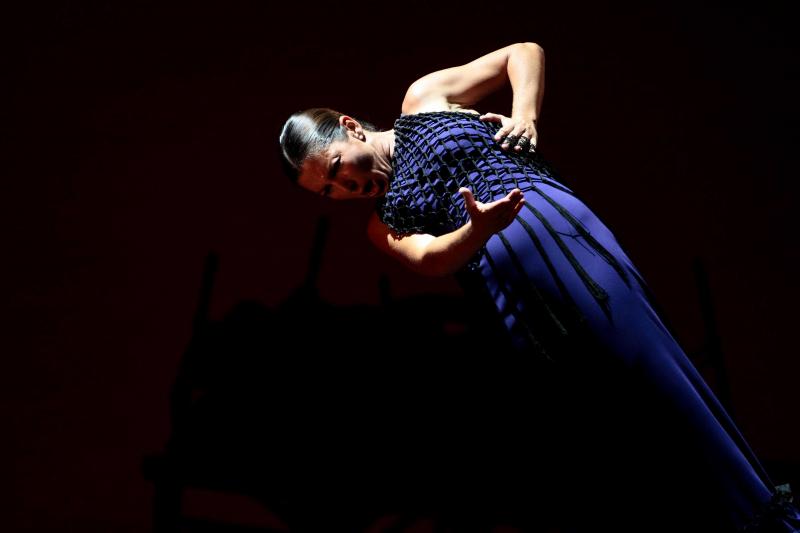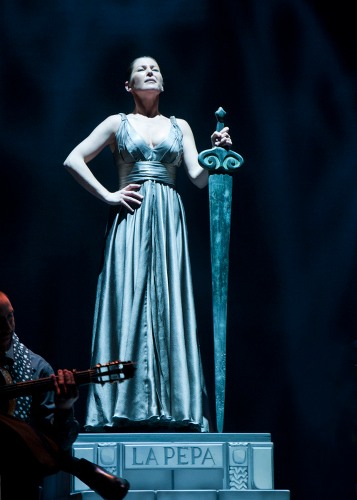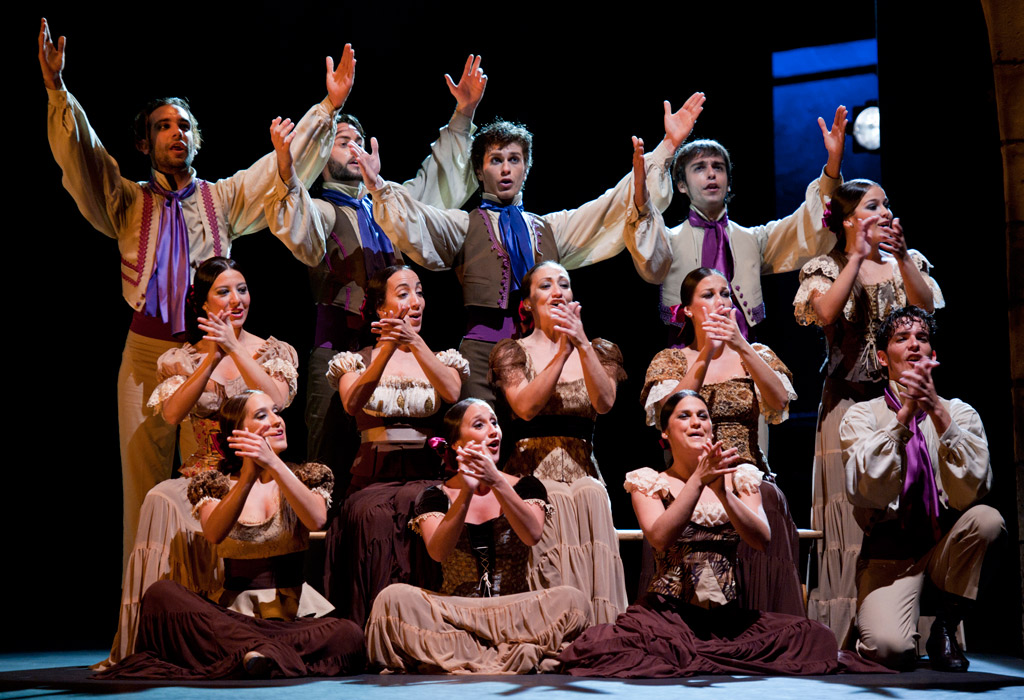La Pepa, Ballet Flamenco Sara Baras, Sadler's Wells | reviews, news & interviews
La Pepa, Ballet Flamenco Sara Baras, Sadler's Wells
La Pepa, Ballet Flamenco Sara Baras, Sadler's Wells
Flamenco festival's opening number is no history lesson, but the dancing's all right

“Goya!” I scribbled enthusiastically in the first moments of La Pepa. “Dos de Mayo!
 La Pepa is the nickname for the 1812 Spanish Constitution of Cádiz, which happens to be the hometown of Sara Baras. This show, created for the constitution’s bicentenary, clearly wants to offer us some new kind of knowledge and appreciation of La Pepa - but is it a homage? A history? A ritual reenactment? The Goya moments, the great stone arches of the set, and the historical costumes of the dancers might suggest a piece of impassioned historical storytelling, a Spanish Les Misérables-cum-courtroom drama. But flamenco, a dance form with no real mime or narrative tradition, can’t sustain anything as complex as history.
La Pepa is the nickname for the 1812 Spanish Constitution of Cádiz, which happens to be the hometown of Sara Baras. This show, created for the constitution’s bicentenary, clearly wants to offer us some new kind of knowledge and appreciation of La Pepa - but is it a homage? A history? A ritual reenactment? The Goya moments, the great stone arches of the set, and the historical costumes of the dancers might suggest a piece of impassioned historical storytelling, a Spanish Les Misérables-cum-courtroom drama. But flamenco, a dance form with no real mime or narrative tradition, can’t sustain anything as complex as history.
Baras herself suggests La Pepa is “a feeling, an attitude, a way of being”. Fair enough, but this kind of contention loads her show with the burden of representing (her words again) “the horror of a war, the beauty of the land, the importance to create [sic] an historical constitution in the whole world; the influence, the hope, the happiness, the life and freedom.” Clearly Baras has no doubt she is up to it; a woman of granite-dense stage presence (like her compatriot Eva Yerbabuena), she confidently appears at the end, Statue of Liberty-like, on a pedestal labelled La Pepa (pictured, above right), as if she herself embodies her nation, its history, and the spirit of freedom.
But whether we in the audience can accept that kind of claim depends on whether one accepts flamenco as some kind of embodiment of the Spanish soul. For those who do, the blistering intensity of Baras and her co-performers will justify their grand aspirations. This is no gentle, folksy dance form. The cliché of labelling flamenco "passionate" is trying to get at the fact that a dance requiring so much tension in the body, and transmuting that tension into so much noise, must be feeding off the strong emotions: anger, grief, love. The same emotions form the soundtrack, heard in the mournful wailing of the singers, insistent as a call to prayer, and the blistering cajón duet played by Antonia Suárez and Manuel Muñoz – a high point for me, and one touchingly capped by the performers embracing in self-congratulatory exhaustion.
 The thrill of flamenco is all about percussion: the relentless Gatling-gun barrage of sound from feet stamping so furiously the eye sees only a blur, as well as the drum-cadenza exhilaration of broken, syncopated, and ornamented rhythm. The speed is incredible – a woodpecker going at this rate would fell an oak tree in an hour, while a pianist might manage the same volume of notes, but she has ten fingers; the flamenco artist only four (the front and back of each foot). With virtuosic skill, Baras and her male counterpart José Serrano amply demonstrate the stunning power of this dance form in the hands (and feet) of masters (and they could have done so without mikes on their shoes, an invasive annoyance in an overamplified performance.)
The thrill of flamenco is all about percussion: the relentless Gatling-gun barrage of sound from feet stamping so furiously the eye sees only a blur, as well as the drum-cadenza exhilaration of broken, syncopated, and ornamented rhythm. The speed is incredible – a woodpecker going at this rate would fell an oak tree in an hour, while a pianist might manage the same volume of notes, but she has ten fingers; the flamenco artist only four (the front and back of each foot). With virtuosic skill, Baras and her male counterpart José Serrano amply demonstrate the stunning power of this dance form in the hands (and feet) of masters (and they could have done so without mikes on their shoes, an invasive annoyance in an overamplified performance.)
Their grand solos go on far too long too, in a production which at two hours is already stretching patience. I would have liked to see more of the actually rather good choreography Baras has made for her supporting dancers. In corsets and tiered skirts (the women) and fetching sashed shirts and knee boots (the men), the eager dancers of the corps (pictured above left) have the isn’t-this-jolly smiles of a chorus line, and manage in their synchronicity and uniformity to suggest the weight of a national story, a national tradition. Baras is incredible yes, but why does she get to wear a totally anachronistic 1920s-meets-1990s fringed number while everyone else is in period costume? It jars, and more than that, it illustrates what’s not quite right here: though this show features many other performers, and purports to tell a story valid for all Spain, if not all time, it is really all about Sara Baras. For lovers of flamenco and of Sara that might be enough, but if you’re looking for art to tell you about Spanish history, better stick to Goya.
- La Pepa is at Sadler's Wells as part of their Flamenco Festival until 8 March.
rating
Explore topics
Share this article
Add comment
The future of Arts Journalism
You can stop theartsdesk.com closing!
We urgently need financing to survive. Our fundraising drive has thus far raised £49,000 but we need to reach £100,000 or we will be forced to close. Please contribute here: https://gofund.me/c3f6033d
And if you can forward this information to anyone who might assist, we’d be grateful.

Subscribe to theartsdesk.com
Thank you for continuing to read our work on theartsdesk.com. For unlimited access to every article in its entirety, including our archive of more than 15,000 pieces, we're asking for £5 per month or £40 per year. We feel it's a very good deal, and hope you do too.
To take a subscription now simply click here.
And if you're looking for that extra gift for a friend or family member, why not treat them to a theartsdesk.com gift subscription?
more Dance
 'We are bowled over!' Thank you for your messages of love and support
Much-appreciated words of commendation from readers and the cultural community
'We are bowled over!' Thank you for your messages of love and support
Much-appreciated words of commendation from readers and the cultural community
 Peaky Blinders: The Redemption of Thomas Shelby, Rambert, Sadler's Wells review - exciting dancing, if you can see it
Six TV series reduced to 100 minutes' dance time doesn't quite compute
Peaky Blinders: The Redemption of Thomas Shelby, Rambert, Sadler's Wells review - exciting dancing, if you can see it
Six TV series reduced to 100 minutes' dance time doesn't quite compute
 Giselle, National Ballet of Japan review - return of a classic, refreshed and impeccably danced
First visit by Miyako Yoshida's company leaves you wanting more
Giselle, National Ballet of Japan review - return of a classic, refreshed and impeccably danced
First visit by Miyako Yoshida's company leaves you wanting more
 Quadrophenia, Sadler's Wells review - missed opportunity to give new stage life to a Who classic
The brilliant cast need a tighter score and a stronger narrative
Quadrophenia, Sadler's Wells review - missed opportunity to give new stage life to a Who classic
The brilliant cast need a tighter score and a stronger narrative
 The Midnight Bell, Sadler's Wells review - a first reprise for one of Matthew Bourne's most compelling shows to date
The after-hours lives of the sad and lonely are drawn with compassion, originality and skill
The Midnight Bell, Sadler's Wells review - a first reprise for one of Matthew Bourne's most compelling shows to date
The after-hours lives of the sad and lonely are drawn with compassion, originality and skill
 Ballet to Broadway: Wheeldon Works, Royal Ballet review - the impressive range and reach of Christopher Wheeldon's craft
The title says it: as dancemaker, as creative magnet, the man clearly works his socks off
Ballet to Broadway: Wheeldon Works, Royal Ballet review - the impressive range and reach of Christopher Wheeldon's craft
The title says it: as dancemaker, as creative magnet, the man clearly works his socks off
 The Forsythe Programme, English National Ballet review - brains, beauty and bravura
Once again the veteran choreographer and maverick William Forsythe raises ENB's game
The Forsythe Programme, English National Ballet review - brains, beauty and bravura
Once again the veteran choreographer and maverick William Forsythe raises ENB's game
 Sad Book, Hackney Empire review - What we feel, what we show, and the many ways we deal with sadness
A book about navigating grief feeds into unusual and compelling dance theatre
Sad Book, Hackney Empire review - What we feel, what we show, and the many ways we deal with sadness
A book about navigating grief feeds into unusual and compelling dance theatre
 Balanchine: Three Signature Works, Royal Ballet review - exuberant, joyful, exhilarating
A triumphant triple bill
Balanchine: Three Signature Works, Royal Ballet review - exuberant, joyful, exhilarating
A triumphant triple bill
 Romeo and Juliet, Royal Ballet review - Shakespeare without the words, with music to die for
Kenneth MacMillan's first and best-loved masterpiece turns 60
Romeo and Juliet, Royal Ballet review - Shakespeare without the words, with music to die for
Kenneth MacMillan's first and best-loved masterpiece turns 60
 Help to give theartsdesk a future!
Support our GoFundMe appeal
Help to give theartsdesk a future!
Support our GoFundMe appeal

Comments
Your review is nonsense. you
Esoty de acuerdo con Maria.
This is such a soppy review.
Were we even watching the